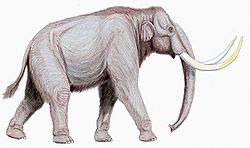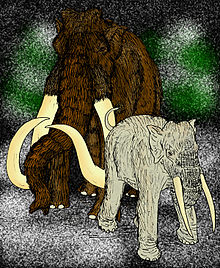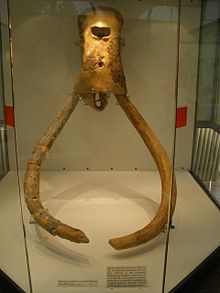- Steppe mammoth
-
Steppe mammoth
Temporal range: Mid Pleistocene
Conservation status PrehistoricScientific classification Kingdom: Animalia Phylum: Chordata Class: Mammalia Order: Proboscidea Family: Elephantidae Genus: Mammuthus Species: M. armeniacus Binomial name Mammuthus armeniacus
Falconer, 1857Synonyms[1] Mammuthus trogontherii Pohlig, 1888
The steppe mammoth, Mammuthus armeniacus, is an extinct species of Elephantidae, that ranged over most of northern Eurasia during the Middle Pleistocene, 600,000-370,000 years ago.
The steppe mammoth probably evolved in Siberia during the early Pleistocene from Mammuthus meridionalis, which was replaced during the middle Pleistocene about 750,000 - 500,000 years ago. It was the first stage in the evolution of the steppe and tundra elephants and an ancestor of the woolly mammoth of the later glacial periods.
Contents
Description
Standing up to 4.70 m (15 ft) tall at the shoulder, it is among the largest proboscideans to have ever lived, along with other species of Eurasian mammoth, North American mammoth and Deinotherium. Its spiral-shaped tusks could be as long as 5.2 metres (17 ft) in old bulls. About 250.000 years ago, the woolly mammoth, which derived in northern Asia from the steppe mammoth, appeared in Europe, and replaced its progenitor completely.
Its skull was shorter than that of the great southern elephant. The males had spiral tusks with a recurved tip, while the females had thinner and only slightly curved tusks. The tusks grew to considerable lengths and the largest one known must have measured about 5 m. on a living animal.
Fossils
Fossilized teeth are recovered, but skeletal parts are rare. The most complete skeleton of a steppe mammoth yet found was discovered in 1996 in Kikinda, Serbia. It has recently been mounted and put on display. The specimen is a female, which was about 4.7 metres (15 ft) high, with 3.5 metres (11 ft) long tusks, and would have weighed an estimated 7 tons when alive. This suggests even greater dimensions for males from the same area. It therefore seems that M. armeniacus is not only the biggest species of the genus Mammuthus, but is possibly among the biggest species in the order Proboscidea, rivaling in size not only Elephas recki and the Straight-tusked elephant Palaeoloxodon but, perhaps, even Deinotherium itself.
Another quite complete steppe mammoth was excavated in the cliffs of West Runton in Norfolk, UK; it preserves its jaws and teeth but is missing the upper part of its skull. A rare skull found in Auvergne, France, in 2008 will be examined in the Musée Crozatier, Le Puy-en-Velay.[2]
See also
- Deinotherium
- Elephas recki
- Mammuthus imperator
- Mammuthus sungari
- Palaeoloxodon
- Paraceratherium
- West Runton elephant
Literature
- Benes, Josef: Prehistoric Animals and Plants, Pg. 271. Prague, Artua: 1979.
- Jordi Augusti and Mauricio Anton: Mammoths, Sabertooths and Hominids 65 Million Years of Mammalian Evolution in Europe, Columbia University Press, 2002. ISBN 0-231-11640-3
- Lister, Adrian und Bahn, Paul: Mammuts - Riesen der Eiszeit, Thorbecke Verlag, Sigmaringen 1997. ISBN 3-7995-9050-1
Notes
- ^ Todd, Nancy E. (January 2010). "New Phylogenetic Analysis of the Family Elephantidae Based on Cranial-Dental Morphology". The Anatomical Record: Advances in Integrative Anatomy and Evolutionary Biology (Wiley-Liss, Inc.) 293 (1): 74–90. doi:10.1002/ar.21010.
- ^ Rincon, Paul (2 September 2008). "'Rare' mammoth skull discovered". BBC News. http://news.bbc.co.uk/2/hi/science/nature/7592317.stm. Retrieved 2 September 2008.
External links
- Prehistoric elephants
- Pleistocene mammals
- Megafauna of Eurasia
- Prehistoric mammal stubs
Wikimedia Foundation. 2010.


